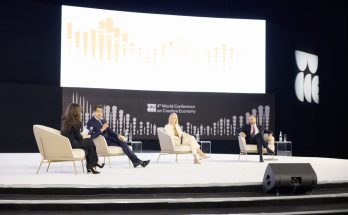 Against the setting sun and the rising full moon, Humayun’s Tomb shimmered in all its restored glory. Six years of extensive work had restored the 16th century mosque to its former magnificence. The place came alive on September 18 as state leaders, high-level dignitaries and the crème da le crème of New Delhi’s society walked around the tomb complex, admiring the Mughal craftsmanship and architecture that had fallen prey to neglect and disrepair. Later in the evening maestro Ustad Shujat Husain Khan’s sitar recital transported one to a different era.
Against the setting sun and the rising full moon, Humayun’s Tomb shimmered in all its restored glory. Six years of extensive work had restored the 16th century mosque to its former magnificence. The place came alive on September 18 as state leaders, high-level dignitaries and the crème da le crème of New Delhi’s society walked around the tomb complex, admiring the Mughal craftsmanship and architecture that had fallen prey to neglect and disrepair. Later in the evening maestro Ustad Shujat Husain Khan’s sitar recital transported one to a different era.
The UNESCO World Heritage Site, which inspired the icon Taj Mahal, has been restored by Aga Khan Trust for Culture (AKTC), Sir Dorabji Tata Trust and the Archaeological Survey of India in a public-private partnership. In what has been dubbed as the largest and most ambitious heritage conservation project undertaken in India, more than 1,000 artisans, some from Uzbekistan – founder of Mughal empire Babur’s homeland –and others from different parts of India, were involved in bringing back the monument to its original splendor.
Minute details were looked into. The fact that it took two years for artisans to just match the turquoise colour used in the original structure; that the small domes with peacock blue tiles – the legacy of Persian influence on the Mughal architecture – were brought back after being nearly lost to dust; that each stone was individually inspected; that wooden doors, lattices were repaired are all proof of the kind of effort that has gone into the project.
 Earlier in September, two handcrafted Egyptian lamps with Islamic motifs, similar to the original, were installed in the main chamber and the west gate. Till about the 19th century, similar lamps in the monument were mentioned in travellers’ accounts but later they went missing. Now nearly after two centuries, the lamps are back in the tomb. The new brass lamps were brought to Delhi from Cairo, where they were made in a traditional lamp-making workshop undertaken by AKTC.
Earlier in September, two handcrafted Egyptian lamps with Islamic motifs, similar to the original, were installed in the main chamber and the west gate. Till about the 19th century, similar lamps in the monument were mentioned in travellers’ accounts but later they went missing. Now nearly after two centuries, the lamps are back in the tomb. The new brass lamps were brought to Delhi from Cairo, where they were made in a traditional lamp-making workshop undertaken by AKTC.
Commissioned in 1562 by Begum Bega, widow of Mughal emperor Humayun, Babur’s son and second Mughal emperor of India, the mausoleum suffered serious damage in the 20th century when cement was used for restoration. Over the years, government apathy led to its further deterioration. It was only in 1999, when the first phase of restoration was started and ended by 2003 with 12 hectares of lawns replanted, 2500 trees planted and a new water circulation system for the central walkaway installed. Then again in 2007, restoration was undertaken by AKTC, this t ime to remove the cement and bring back the original character of the monument. But before beginning the work, significant archival research and documentation was done. Even the conservation plan was later peer-reviewed by international experts. In fact, the conservation process was experimented for four years under the guidance of master craftsmen from Uzbekistan. Over six years, millions of tonnes of cement were removed. It was a painstaking effort which was carried out with a missionary zeal. Six years later, the result is for everybody to see. The monument is back to its original glory.
ime to remove the cement and bring back the original character of the monument. But before beginning the work, significant archival research and documentation was done. Even the conservation plan was later peer-reviewed by international experts. In fact, the conservation process was experimented for four years under the guidance of master craftsmen from Uzbekistan. Over six years, millions of tonnes of cement were removed. It was a painstaking effort which was carried out with a missionary zeal. Six years later, the result is for everybody to see. The monument is back to its original glory.
While inaugurating the refurbished tomb September 18, India’s Prime Minister Manmohan Singh waxed eloquent. “India has one of the richest repositories of heritage anywhere in the world and it is critical that we find practical and innovative ways to preserve and maintain this heritage,” he said. “The Humayun’s Tomb project has provided 200,000 man-days of employment for master craftsmen, demonstrating the potential of conservation works to fulfil a significant government objective,” he noted.
 Humayun’s Tomb is the finest example of Mughal architecture in India. It was the first monument which was adopted the Persian architectural style of charbagh (four gardens). Explains Ratish Nanda, the project director, in The National: “The whole point of the Humayun’s tomb was that the Mughal builders were replicating Quranic description of paradise. The holy Quran repeatedly promises the faithful gardens beneath which rivers flow as the final resting place. The Mughals took that idea and created this, with gardens and channels of water.”
Humayun’s Tomb is the finest example of Mughal architecture in India. It was the first monument which was adopted the Persian architectural style of charbagh (four gardens). Explains Ratish Nanda, the project director, in The National: “The whole point of the Humayun’s tomb was that the Mughal builders were replicating Quranic description of paradise. The holy Quran repeatedly promises the faithful gardens beneath which rivers flow as the final resting place. The Mughals took that idea and created this, with gardens and channels of water.”
Indeed, it’s a befitting tribute – a timely one – to the Mughal emperor who introduced Persian artists to India who combined local art with Islamic architecture. Nanda has underlined that the idea was to respect the original builders’ intentions; it looks the mission has been accomplished.
Author Profile
- India Writes Network (www.indiawrites.org) is an emerging think tank and a media-publishing company focused on international affairs & the India Story. Centre for Global India Insights is the research arm of India Writes Network. To subscribe to India and the World, write to editor@indiawrites.org. A venture of TGII Media Private Limited, a leading media, publishing and consultancy company, IWN has carved a niche for balanced and exhaustive reporting and analysis of international affairs. Eminent personalities, politicians, diplomats, authors, strategy gurus and news-makers have contributed to India Writes Network, as also “India and the World,” a magazine focused on global affairs.
Latest entries
 DiplomacyJanuary 5, 2026India walks diplomatic tightrope over US operation in Venezuela
DiplomacyJanuary 5, 2026India walks diplomatic tightrope over US operation in Venezuela India and the WorldNovember 26, 2025G20@20: Africa’s Moment – The Once and Future World Order
India and the WorldNovember 26, 2025G20@20: Africa’s Moment – The Once and Future World Order DiplomacyOctober 4, 2025UNGA Resolution 2758 Must Not Be Distorted, One-China Principle Brooks No Challenge
DiplomacyOctober 4, 2025UNGA Resolution 2758 Must Not Be Distorted, One-China Principle Brooks No Challenge India and the WorldJuly 26, 2025MPs, diplomats laud Operation Sindoor, call for national unity to combat Pakistan-sponsored terror
India and the WorldJuly 26, 2025MPs, diplomats laud Operation Sindoor, call for national unity to combat Pakistan-sponsored terror







